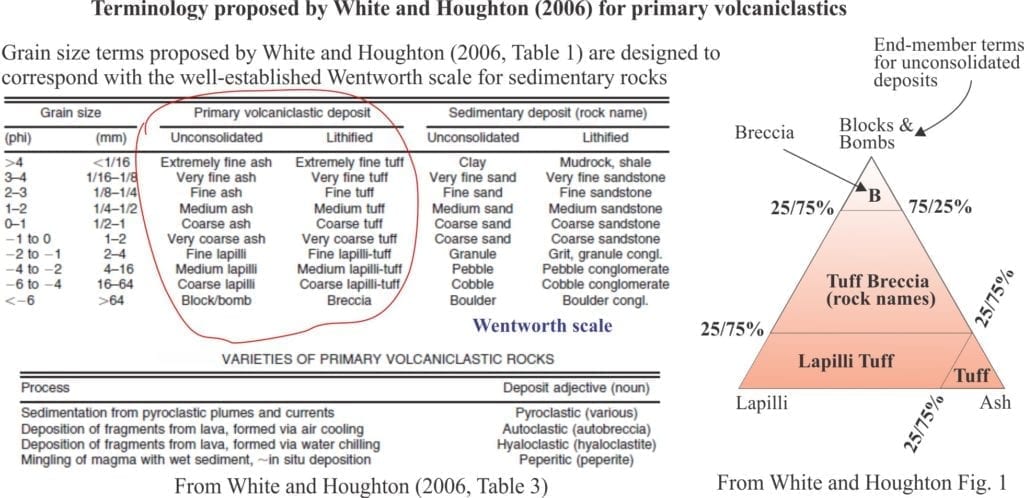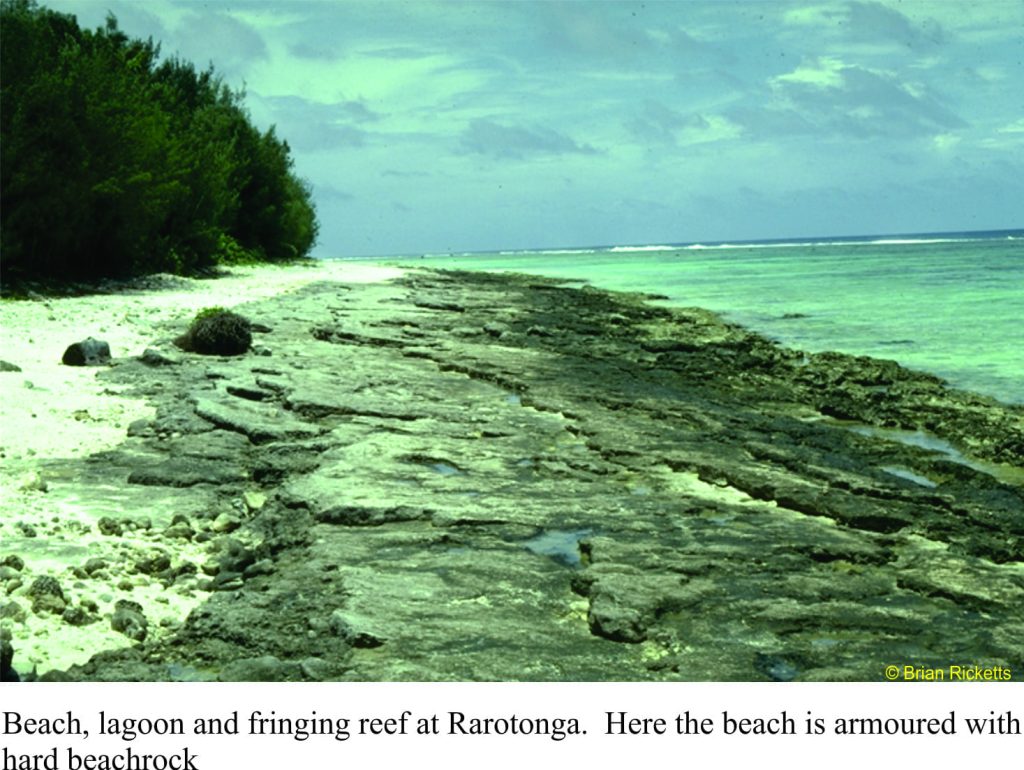

Plinian eruption of Raikoke volcano, Kuril Islands, June 22, 2019. Estimated height of the plume is 13-17 km. Umbrella region clearly developed where density of plume is the same as air density and plume stops rising. Downwind dispersal of the plume distributes fine ash over a wide area. Image credit: NASA Earth Observatory images by Joshua Stevens, Astronaut photograph ISS059-E-119250.
A look at volcaniclastics – pyroclastic fall deposits in outcrop
This is part of the How To… series on describing rocks that in this post focuses on Primary Volcaniclastics in outcrop. Although the series focuses on sediments and sedimentary rocks, I have added these posts on volcanics because of their importance to sedimentary basin dynamics and basin stratigraphy.
Ruapehu, Tongariro, and Ngauruhoe, three active andesite stratovolcanoes in central North Island, New Zealand, are drawing cards for hikers, skiers and general hangers-on; hundreds of 1000s a year. On a foggy September night in 2007, a couple of hikers (sensibly) took shelter in a hut near the summit of Ruapehu. At 8.26 that evening, and with no warning, the volcano erupted explosively, not a large eruption, but violent enough to hurl ash and blocks up to 2km from the vent (Kilgour et al, 2010). One of those blocks crashed through the roof of the hut and crushed a leg of one hiker, narrowly missing the other person. Happily, both survived the ordeal, although one leg was lost.
The projectile that caused the damage was a large ballistic, a piece of rock fragmented by the wet (phreatomagmatic) eruption and thrown from the crater (that was also filled by a small lake), along with ash, lapilli, and lots of steam. Fragments of vent rock and magma formed by explosive eruptions are called pyroclasts. Pyroclasts are ejected from the vent in eruption columns and plumes, jets, and as ballistics. Fragments of all sizes fall from the air under the influence of gravity; they accumulate as pyroclastic fall deposits.
Pyroclastic fall deposits are the product of three main kinds of eruption:
- Magmatic eruptions, where fragmentation results from extremely rapid decompression of gas in rising magma. Pyroclasts consist almost entirely of juvenile material derived from the magma.
- Phreatic eruptions; where rock heated by magma comes into contact with groundwater or seawater, but does not involve new magma (i.e. the magma itself does not erupt), and
- Phreatomagmatic eruptions, where rising magma comes into contact with water; the island Surtsey (Iceland) is an iconic example. (Houghton et al. 2015; Wilson et al, 2009). Hyalotuffs are the depositional product of phreatomagmatic eruptions. They tend to be glassy, and finer grained than magmatic eruptions because of the intense reaction between very hot magma and water.
Fragmental debris also forms when lava flows or is extruded into water (sea, lake) or beneath glaciers. In this situation, haloclastites form from thermal shock as the lava is rapidly chilled. They are common in pillow lavas. Hyaloclastites are not discussed further in this article.
Deposition
The trajectory and distance pyroclasts travel along a flight path depends mainly on:
- The explosivity of the eruption (i.e. the amount of kinetic energy imparted). The degree of fragmentation also increases with explosivity – Strombolian fire- fountains contain a lot of lava spatter in contrast to Plinian eruptions that completely obliterate the original magma.
- The height of the eruption column; higher columns tend to result in widespread distribution. This is particularly evident in the case of Plinian and ultraplinian eruptions with columns entering the upper troposphere.
- The size and density of the fragments. Clast density (and composition) is usually constant during any single eruption but may change as the eruption cycle and magma composition evolve.
- wind strength and direction at the time of the eruption.
Pyroclastic fall deposits also evolve from pyroclastic density currents (pyroclastic flows) when ash and lapilli are elutriated from the top of fast-moving flows. Deposits of this type are also called co-ignimbrite fall tephras.
Eruption style, fragmentation, pyroclast dispersal and volume are summarized in the diagram below, and keyed to the (log scale) Volcanic Explosivity Index (VEI). Descriptive terms are also applied to the various eruptions. Hawaiian eruptions are quiet or gentle, Vulcanian verge on the catastrophic, while Plinian and more energetic eruptions are frighteningly paroxysmic to colossal; Yellowstone supervolcano (632 Ka) falls into the latter category, as did Toba (northern Sumatra, 74Ka), and the most recent event at Taupo a mere 1800 years ago.
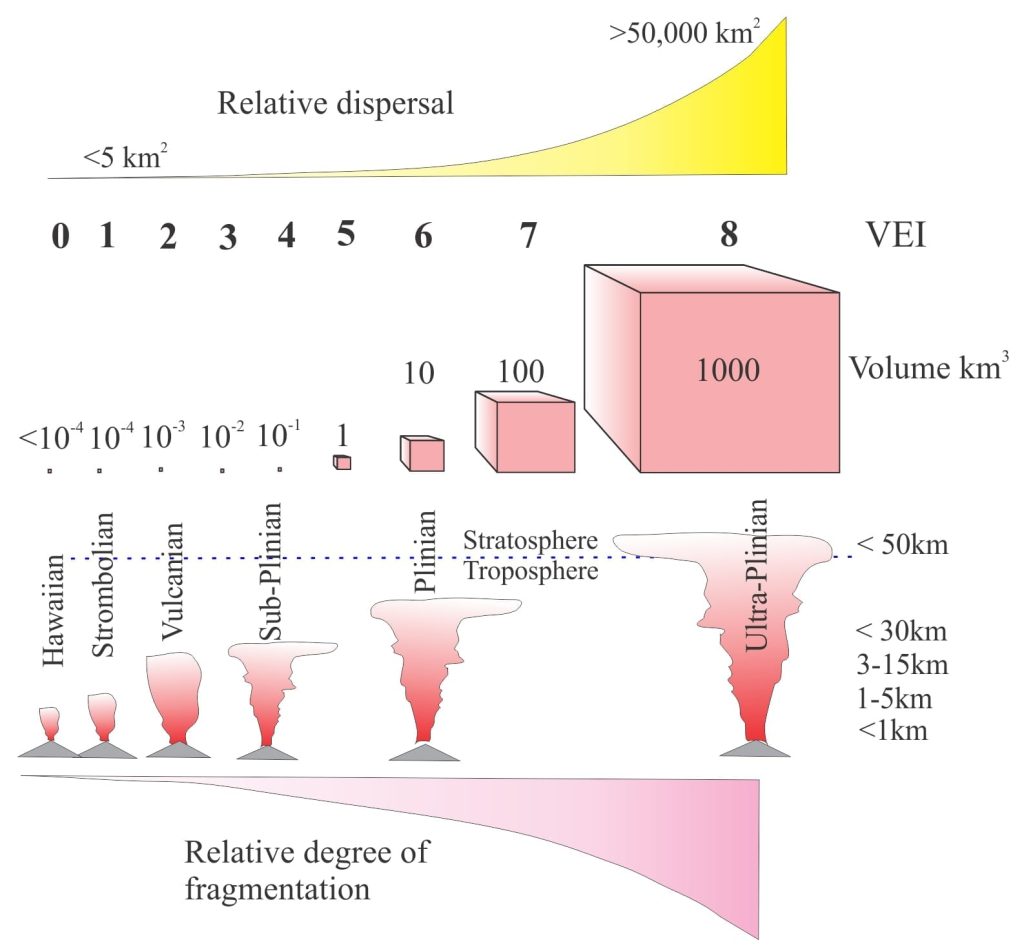

Comparison of principal eruption styles, their explosivity (VEI), dispersal and volumes. Information based on Newhall and Self, 1982; Newhall et al. 2018, and the USGS.
Attributes commonly used to identify fall deposits
(information from various sources, including Pierson et al, 2017; Houghton et al, 2015). The classification is that of White and Houghton, 2006.
1. They tend to mantle topography. Compare this with fluvial reworked volcaniclastics, the locus of which is confined to topographic lows, and pyroclastic flows and surges that thin or pinch out over topographic highs. However, subsequent reworking of airfall tephras by precipitation runoff may preferentially erode material on elevated ground, depositing it in adjacent valleys.
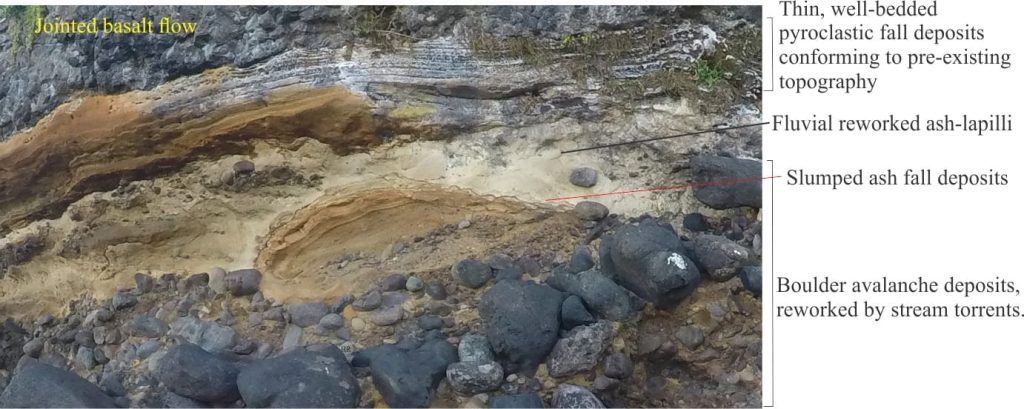

Well-bedded airfall tephras mantle fluvial-reworked tephras and boulder avalanche deposits on the flank of the Pliocene stratovolcano Karioi, New Zealand.
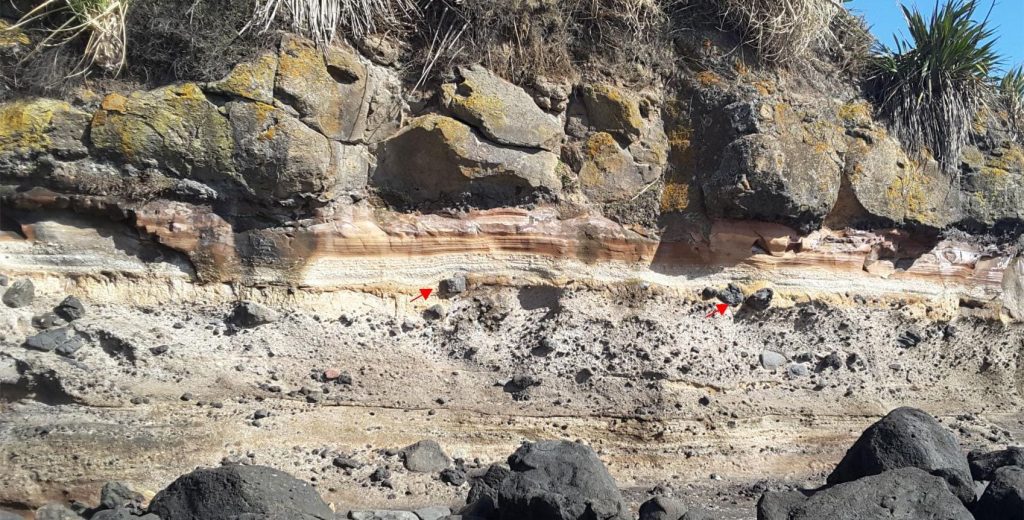

Thin bedded Pliocene airfall tephras mantle boulders that protrude from a pyroclastic surge deposit, Karioi, Raglan, New Zealand.
2. Fall deposits are generally better sorted than other primary volcaniclastics. Sorting in this case is a function of gravitational settling, and the aerodynamic response to clast size, shape, and density.
3. Bedding contacts are commonly abrupt. Beds will be thicker near the source, thinning downwind. Any crossbedding is likely associated with fluvial processes or pyroclastic surges. Maps of bed thickness (isopachs) will help decipher eruption style and intensity, and any changes in dispersal (by plotting dispersal axes). Ash layers incorporated into epiclastic strata and distributed over a wide area make excellent stratigraphic markers, particularly if they contain datable minerals like zircon.
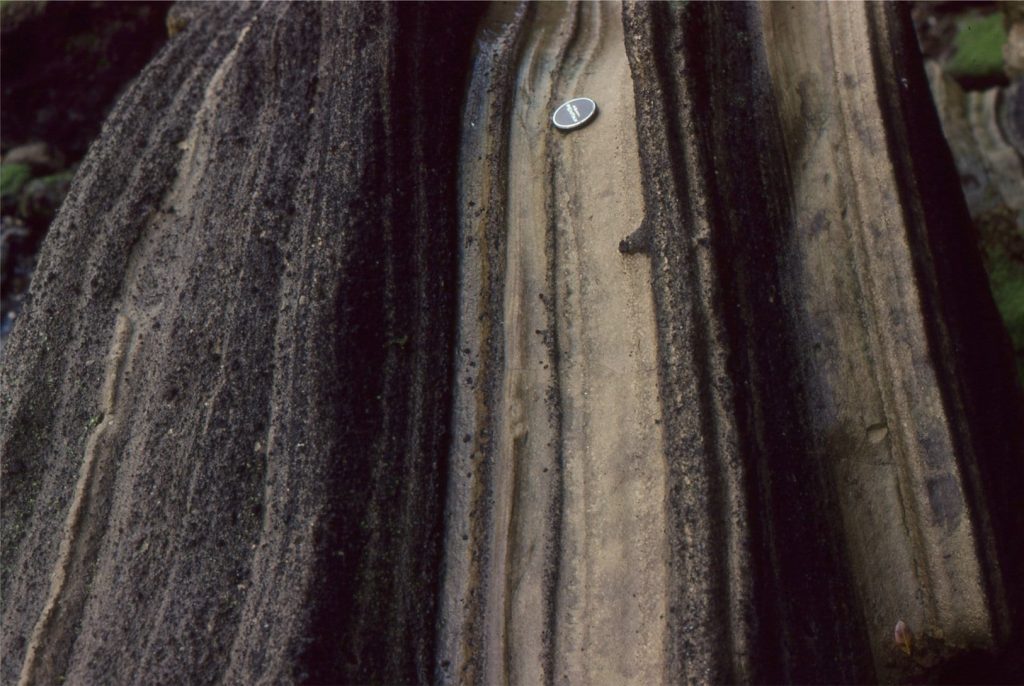

Thin, well-bedded airfall tuff and lapilli tuff, the product of explosive, phreatomagmatic maar volcanism, Ihumatao crater, west Auckland.
4. Within individual beds, the grain size decreases with distance from the vent. However, grain size may vary considerably from one bed to the next because of changes in eruption intensity or prevailing wind strength. Beds may show normal or reverse grading in response to changes in wind intensity or direction, or waxing-waning eruptions. Contour maps of grainsize (isopleths) will help decipher changes in eruption style and intensity.


Steep dipping flank deposits of airfall tuff, lapilli, and angular blocks on the flank of Haleakala, Maui, illustrate variable eruption intensity.
5. Larger fragments may be vesicular; ash particles may show bubble wall textures. Textures like these are common in ‘wet’ phreatic and phreatomagmatic eruptions.
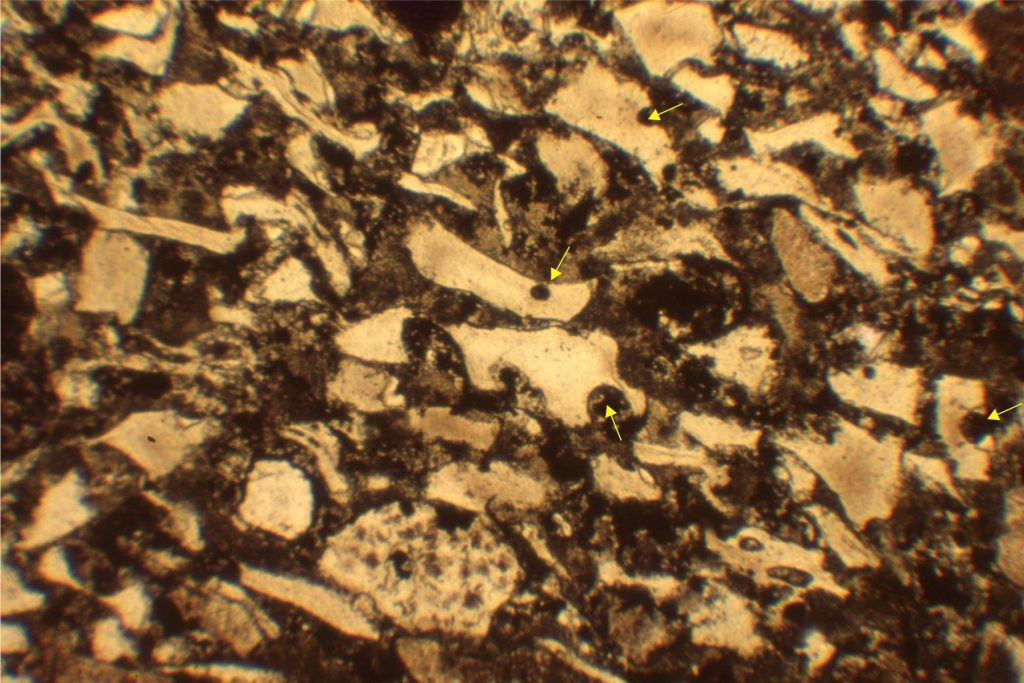

Bubble wall shard textures are common products in wet eruptions. In this thin section view from the Paleoproterozoic Flaherty Formation (Belcher Islands, Canada) the original glass has been replaced by microcrystalline quartz. Plain polarized light. Field of view 8mm.
6. Accretionary lapilli may form in eruption columns containing much water vapour. Their formation is still something of a mystery. Accretionary lapilli will be deposited with other fragmental, although their preservation potential is low.


Close packed accretionary lapilli are mixed with fine ash in these fall deposits associated with Late Pleistocene maar volcanism, Ihumatao, west Auckland. The accretionary lapilli are near-circular, whitish-rimmed structures a few millimetres in diameter.
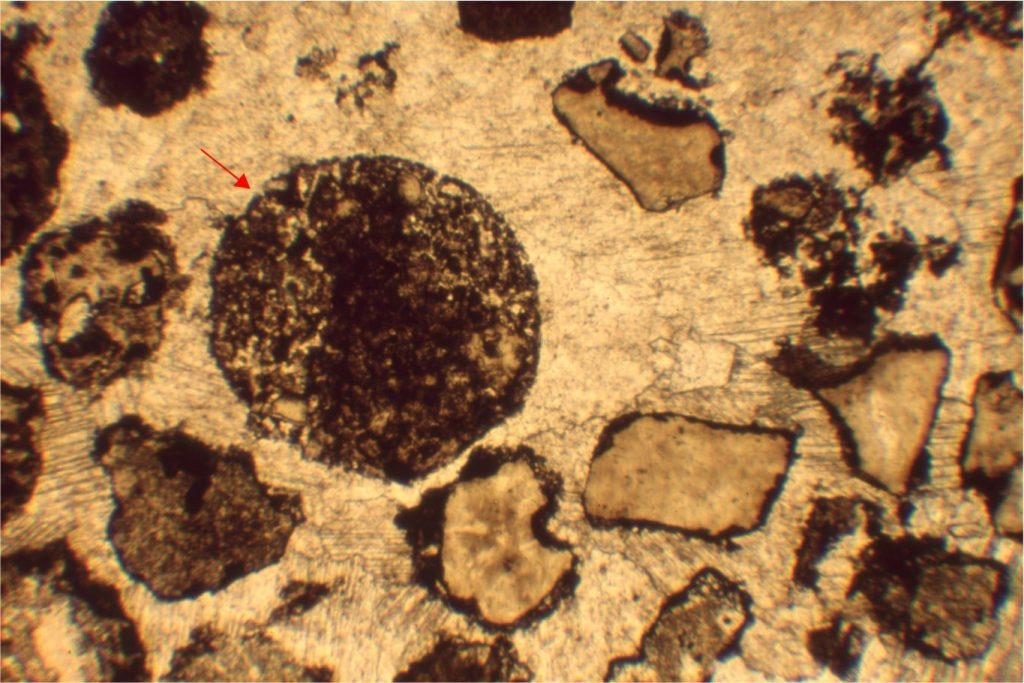

Possible accretionary lapilli mixed with bubble-wall textured ash, Paleoproterozoic Flaherty Formation, Belcher Islands. Coarse calcite and dolomite cement has partly replaced the shard silica. Plain polarized light. Field of view 8mm.
7. Large blocks tend to concentrate near the vent, but again this varies according to eruption intensity. Solid ballistics commonly truncate previously deposited tephra, producing sags in the underlying beds. Ejected lava (particularly in Hawaiian and Strombolian fire fountains, produce spindle bombs that are shaped aerodynamically while being flung through the air. If the lava is still molten when landing it will spatter and cool in a variety of interesting shapes (e.g. cow-pat, bread crust bombs).
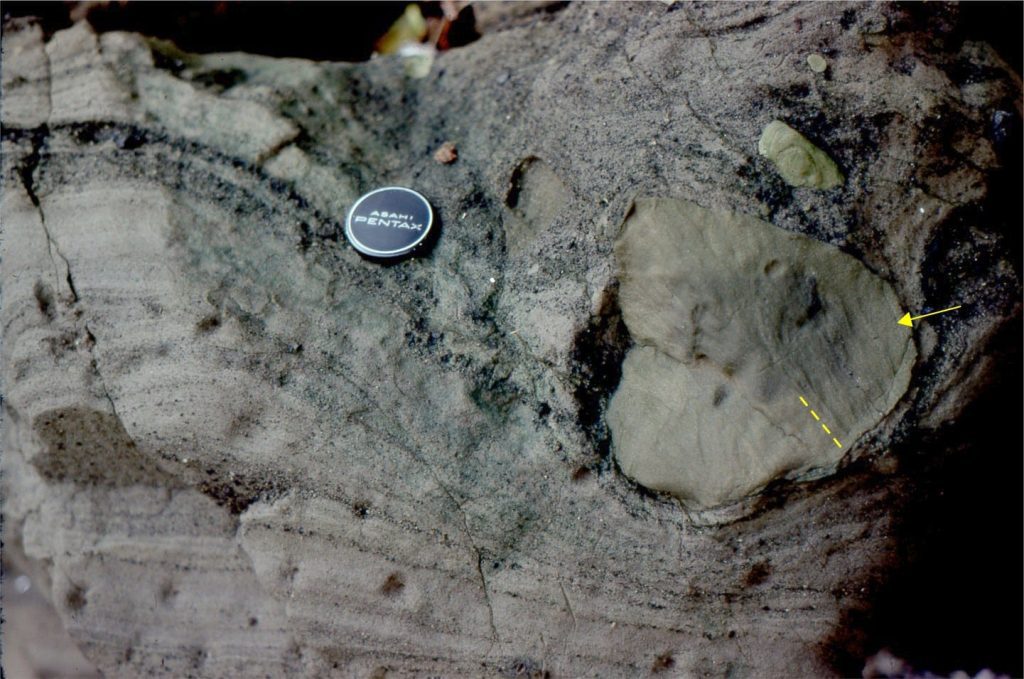

A bomb sag in airfall tephras, Ihumatao, west Auckland. This bomb is a chunk of sandstone country rock, probably ripped from the vent wall during eruption
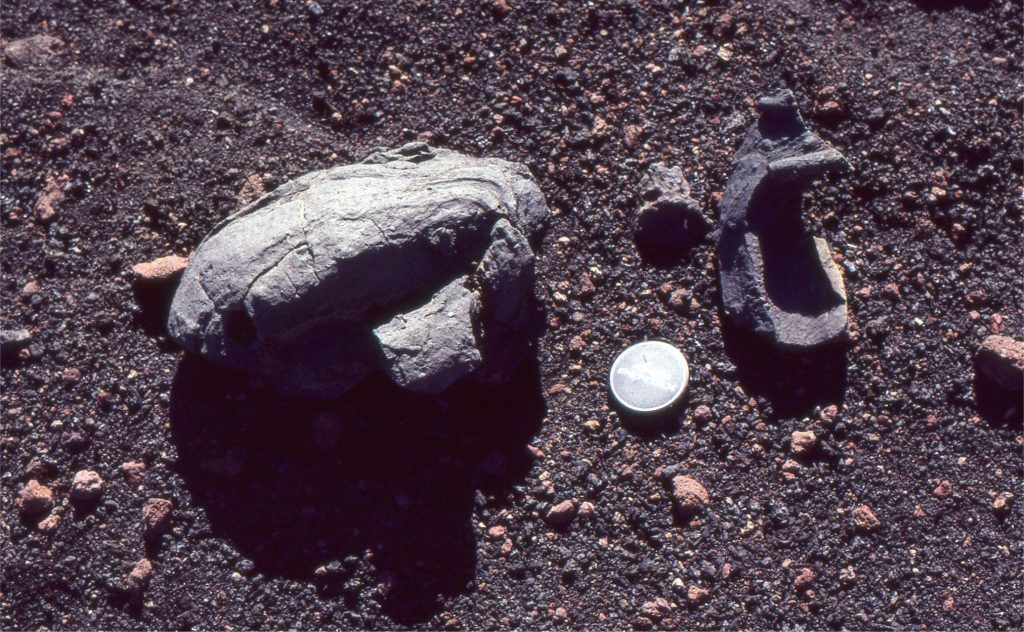

Spindle bomb with fluted sides formed while spinning through the air in a molten state. Part of the spindle has broken off. Haleakala crater, Maui.


Recent (left – Haleakala crater) and Cretaceous (right) cow pat bombs, formed from lava splatter during fire- fountain eruptions. The ancient example is from the Strand Fiord Volcanics, Arctic Canada.


A recent bread crust bomb, Haleakala crater, Maui. The cracks form during preferential cooling of the bomb crust, while the internal part of the fragment is still soft.
8. Airfall deposits of ash and lapilli commonly drape pre-existing topography, and in the process modify that topography. Subsequent erosion will redistribute the volcaniclastics along valley floors, and fluvial channels and floodplains. The examples below are from relatively young eruptions (< 7-9 ka) near Lake Rotoma, Okataina caldera (Taupo Volcanic Zone, New Zealand). They represent two episodes of eruption, separated by an interval of erosion and development of an incipient paleosol. The tephras are associate with rhyolitic and rhyodacitic lava flows, block and ash flows, and ignimbrites.


Airfall tephras draping pre-existing topography accumulated during two eruption episodes (1 and 2), separated by an angular discordance caused by erosion of episode 1 layers. Outcrop is about 2 m high. Southwest Lake Rotoma. Individual tephra layers are about 5 – 60 mm thick – even in this narrow interval there were over 100 depositional events derived from multiple, explosive eruption events. Outcrop is about 2 m high. Southeast Lake Rotoma.
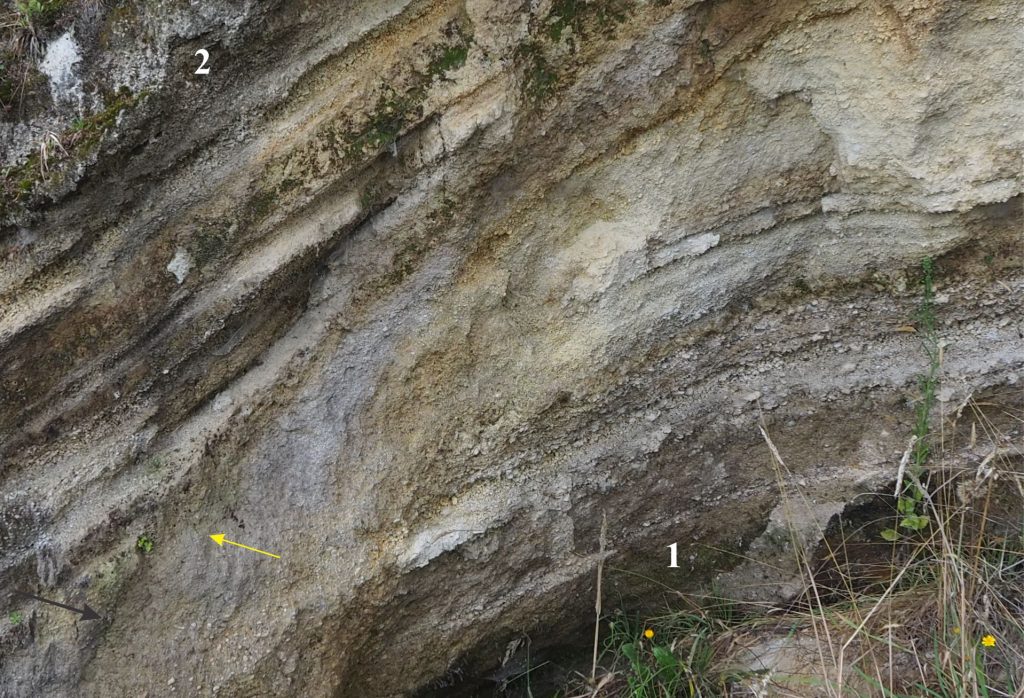

Closer view (left side of drape) showing the discordant contact between the two sets of airfall deposits (black arrow). The more diffuse grey-brown zone that parallels the contact is a weakly formed paleosol (yellow arrow) containing a few fossil root structures – the root systems expand from the contact down into unit 1. Formation of the palesol, that involved some diagenetic alteration of glass and feldspar, and infiltration of some organic matter (pale grey hues) masks the original bedding.
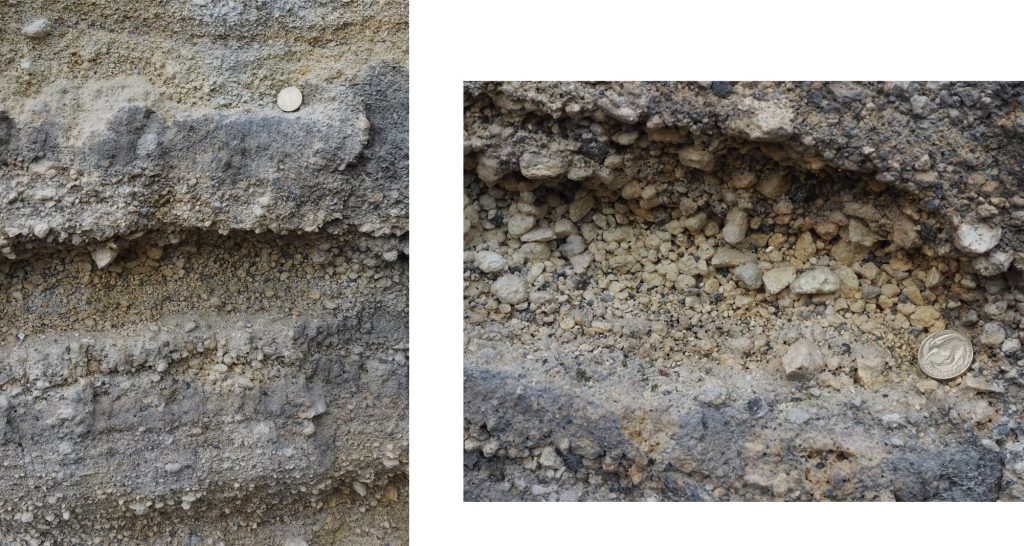

Zooming in on the airfall tephra layers, that consist of glassy ash and relatively dense, low-vesicularity rhyolite. Most lapilli fragments are angular to sub-rounded. Bedding is distinguished by abrupt changes in grain size – the largest fragment in these views is 30 mm. The variation in clast size among layers reflects the explosivity of each eruption jet or column (weak or violent), the trajectory of the fragmentals (vertical or oblique), the spread and shape of each erupted jet or column relative to the depositional site – i.e. is the site located along the axis (coarsest material) or the distal margin (finest material) of each event, recognising that this will change for each successive eruption, and wind and rain conditions. Coin is 22 mm diameter.
Related links in this series on outcrop descriptions
Accretionary aggregates and accretionary lapilli
Ignimbrites in outcrop and thin section
Volcanics in outcrop: Pyroclastic density currents
Volcanics in outcrop: Secondary volcaniclastics
Mount St. Helens: 40th Anniversary
Volcanics in outcrop: Lava flows
Sedimentary structures: Alluvial fans
Sedimentary structures: coarse-grained fluvial
Sedimentary structures: fine-grained fluvial
Sedimentary structures: Mass Transport Deposits
Sedimentary structures: Turbidites
Sedimentary structures: Shallow marine
Sedimentary structures: Stromatolites
Other useful links
Describing sedimentary rocks; some basics
Measuring a stratigraphic section
References
B. F. Houghton, J. D. L. White, A. Van Eaton, 2015. Phreatomagmatic and Related Eruption Styles. Encyclopedia of Volcanoes, 2nd Edition, Springer. Available for download
G. Kilgour, V. Manville, F. Della Pasqua, A. Graettinger, K.A. Hodgson, and G.E. Jolly, 2010. The 25 September 2007 eruption of Mount Ruapehu, New Zealand: Directed ballistics, surtseyan jets, and ice-slurry lahars Journal of Volcanology and Geothermal Research 191 (2010) 1–14
C.G. Newhall and S. Self, 1982. The Volcanic Explosivity Index (VEI): An estimate of explosive magnitude for historical volcanism. Journal of Geophysical Research, v. 87, p. 1231-1238. PDF available
C. Newhall, S. Self, A. Robock 2018. Anticipating future Volcanic Explosivity Index (VEI) 7 eruptions and their chilling impacts. Geosphere v.14 p. 572–603. Open Access
T.C. Pierson, L. Siebert, C.J. Harpel, and K.M. Scott. 2017. Geologic Field-Trip Guide of Volcaniclastic Sediments from Snow- and Ice-Capped Volcanoes—Mount St. Helens, Washington, and Mount Hood, Oregon. USGS Scientific Investigations Report 2017–5022–F. Available for download
J.D.L White and B.F. Houghton, 2006. Primary volcaniclastic rocks. Geology, vol. 34, Issue 8.
C. Wilson, 2001. The 26.5 ka Oruanui eruption, New Zealand: An introduction and overview. Journal of Volcanology and Geothermal Research 112(1):133-174. Available for download
C. Wilson, D.M. Gravley, G.S. Leonard, J. Rowland, 2009. Volcanism in the central Taupo Volcanic Zone, New Zealand: Tempo, styles and controls. Special Publications of IAVCEI

